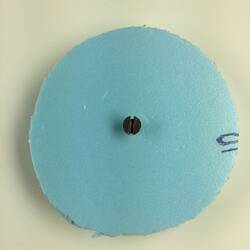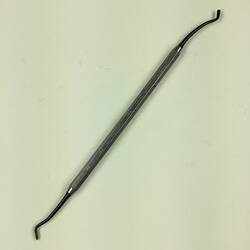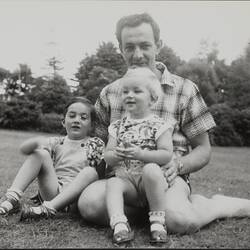Summary
Jewish glass artist Ede Horton's work explores Jewish migration, culture and identity, engaging with traditional Jewish cultural traditions through a contemporary Australian lens.
Introduction:Jewish glass artist Ede Horton has a local and national profile and her work has made a significant contribution to representation of Jewish migration, culture and identity in the Museums's collection, engaging with traditional Jewish cultural traditions through a contemporary Australian lens.
Ede was born in Sydney, her mother Czechoslovakian and father German, both survivors of the Holocaust in Europe. Her Jewish heritage is central to her identity and has worked from her studio in Melbourne since 1981. She is inspired to both celebrate and reinterpret Jewish ritual practices through her glass creations. The Havdalah ceremony represented by the artwork in the Museum's collection incorporates candles, spices, wine and prayer to welcome in the new week.
A video of Ede reflecting on her work (and handling this set) can be viewed on the Immigration Museum Identity exhibition website: https://youtu.be/MPKC4H2tLyM?si=t7qlTh6RzZalmm1m
Artist Biography:
Since 1981, Ede Horton has operated from her own studio in Melbourne, exhibiting regularly in Australia and overseas. Her work is represented in many prestigious collections including Parliament House, Canberra, The Jewish Museum of Australia, Nishida Museum, Toyama, Japan, Ebeltoft Museum, Denmark, Queensland Art Gallery and Wagga Art Gallery, NSW. Her work is also represented in private collections located in Australia, Europe and the United States.
In 2002 she completed a Master of Visual Arts at the Australian National University Canberra School of Art, culminating in a touring exhibition entitled "Memory Works". Solo shows followed at Span Galleries, Melbourne and Jam Factory, Contemporary Craft and Design Centre, Adelaide. Since then Ede have exhibited in group shows worldwide.
Artist Statement:
[2021] 'I was born in Australia, a country unique in its vast open spaces and intense sunlight. I grew up with the smells and sounds that form part of my identity and mingle with my European past to influence my artistic eye. The gumnut and its cycle of life were the inspiration for the Havdalah set. The design of the candleholder is based on a side section of the gumnut after it has flowered. This gumnut is a storehouse of seeds (life) ready to regenerate the earth, the candle a source of light celebrating the start of the new working week. In the traditional blessing, God is praised not just for creating the aromatic spices but for creating (many) kinds (or varieties) of fragrant spices. If fragrances are taken metaphorically to mean identities, this blessing might be said to celebrate the diversity of individual identities within creation.'
[2011] 'The Havdalah set came from my love of nature and the Australian environment and also integrating that into a family tradition, a family ceremony that happens at the close of the day of rest or Shabbat (from sunset on Friday to sunset on Saturday). And we light this to celebrate light, and at the end of the day we quench it in wine. We take, which is like a little gumnut really, and inside are some beautiful australian gumnuts, leaves, bits and pieces. We take the essence of the beauty of Australia, all the people that are here, and we take that fragrance in and we carry that with us for the rest of the week.'
[2021] 'What draws me to the work I do is the excitement I feel when I consider the meaning of beauty. My greatest artistic challenge therefore is to find ways to express my ideas and feelings about beauty that other people can engage with. I was born in Sydney, my childhood in Canberra, unique in its vast open spaces and intense sunlight. The smells and sounds of Australia have mingled with my European family background and have merged to inform my artistic eye.'
'My parents came here separately after WW2 and met in Sydney in 1950. My father fled as a young man from the Nazi regime in Germany to the Phillipines which was invaded by the Japanese, he spent a year hiding in the highlands before the Americans arrived at the end of the war. My mother left the Czech Republic for London where she worked as a cleaner till her English was acceptable, then she became a translator for the British airforce at Bletchley.'
'There are two areas to my art practice. Mostly my artwork is conceptually based and I convey themes using a minimal colour palette. The challenge of balancing this art practice is in sharp contrast to designing and making limited edition Judaica (Jewish ritual objects). The discipline of making these functional, colourful objects which following specific historical guidelines and a definite code of practice is extremely stimulating.'
'Since 1981, I have worked from my studio in Melbourne. I exhibit regularly both in Australia and overseas. My glass sculptures focus on the themes of emotional vulnerability as well as personal and cultural identity. I think of myself as a storyteller. I often take an historical perspective to express how, through many generations, we deal not only with change but also how we recognise and retain the memories and rituals that thread consistently throughout our lives. I believe these very personal perspectives define who we are.'
More Information
-
Keywords
-
Authors
-
Contributors
-
Article types























